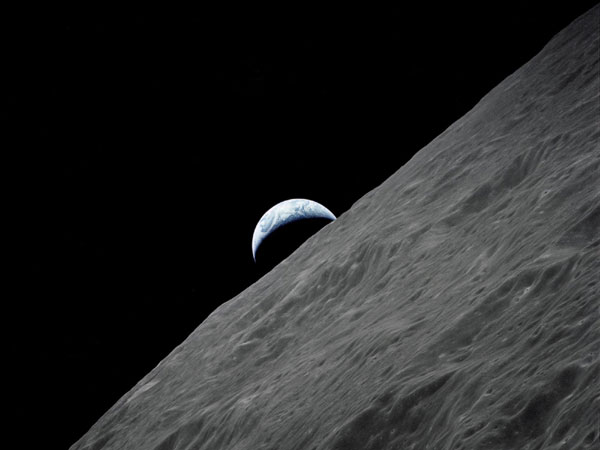Water on Moon, Earth share common origin
Updated: 2013-05-10 09:48
(Xinhua)
|
||||||||
 |
|
The crescent Earth rises above the lunar horizon in this undated NASA handout photograph taken from the Apollo 17 spacecraft in lunar orbit during the final lunar landing mission in the Apollo program. December 13, 2012 marks the 50th anniversary of the last manned lunar trip. [Photo/Agencies] |
WASHINGTON - Water on the Moon and the Earth may originally come from the same place, according to a new analysis of moon rocks.
The findings, published online in the journal Science on Thursday, raise new questions about the process that formed the Moon.
The Moon is thought to have formed from a disc of debris left when a giant object hit the Earth 4.5 billion years ago. Scientists have long assumed that the heat from an impact of that size would cause hydrogen and other volatile elements to boil off into space, meaning the Moon must have started off completely dry.
But recently, US spacecraft and new research on samples from the Apollo missions have shown that the Moon actually has water, both on and beneath its surface.
Alberto Saal, a geochemist at Brown University and the study's lead author, said the "simplest explanation" is that there was water on the proto-Earth at the time of the giant impact.
"Some of that water survived the impact, and that's what we see in the Moon," he said in a statement.
To find the source of the water, Saal and his colleagues relied on a chemical fingerprint, the relative amounts of hydrogen and deuterium, an isotope of hydrogen with an extra neutron.
The researchers found that the deuterium-hydrogen ratio in samples of Moon dust returned by lunar crews of Apollo 15 and 17 was relatively low and matched the ratio found in primitive asteroids called carbonaceous chondrites. These meteorites originated in the asteroid belt near Jupiter and are thought to be among the oldest objects in the solar system. The ratio is also similar to that found in water on the Earth.
The researchers said the fingerprint rules out the possibility that the water on the Moon rocks came from a comet, since comet water tends to have very high deuterium-hydrogen ratios.
"The measurements themselves were very difficult," said Erik Hauri, a co-author of the study at the Carnegie Institution of Washington. "but the new data provide the best evidence yet that the carbon-bearing chondrites were a common source for the volatiles in the Earth and Moon, and perhaps the entire inner solar system."

 Michelle lays roses at site along Berlin Wall
Michelle lays roses at site along Berlin Wall
 Historic space lecture in Tiangong-1 commences
Historic space lecture in Tiangong-1 commences
 'Sopranos' Star James Gandolfini dead at 51
'Sopranos' Star James Gandolfini dead at 51
 UN: Number of refugees hits 18-year high
UN: Number of refugees hits 18-year high
 Slide: Jet exercises from aircraft carrier
Slide: Jet exercises from aircraft carrier
 Talks establish fishery hotline
Talks establish fishery hotline
 Foreign buyers eye Chinese drones
Foreign buyers eye Chinese drones
 UN chief hails China's peacekeepers
UN chief hails China's peacekeepers
Most Viewed
Editor's Picks

|

|

|

|

|

|
Today's Top News
Shenzhou X astronaut gives lecture today
US told to reassess duties on Chinese paper
Chinese seek greater share of satellite market
Russia rejects Obama's nuke cut proposal
US immigration bill sees Senate breakthrough
Brazilian cities revoke fare hikes
Moody's warns on China's local govt debt
Air quality in major cities drops in May
US Weekly

|

|







